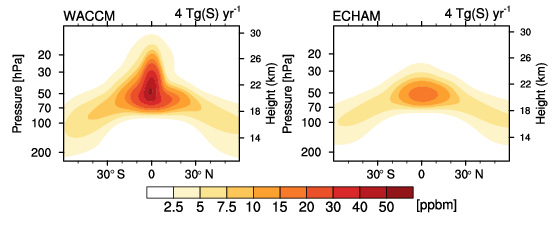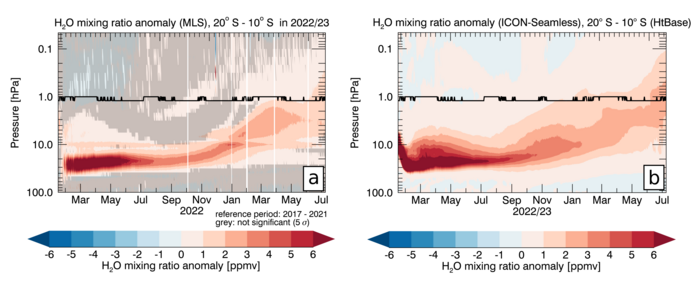Ulrike Niemeier
| Department | Climate Dynamics |
| Group | Director's Research Group (CDY) |
| Position | Scientist |
| phone | +49 40 41173-130 |
| ulrike.niemeier@mpimet.mpg.de | |
| Room | B 418 |
Research interest
Current interests:
- Sulfate aerosols in the stratosphere
- Evolution and transport of sulfur in the stratosphere (aerosol microphysical processes)
- Understanding the micropysical processes after artificial and volcanic injections of sulfur into the stratosphere
- Impact of radiative heating of aerosols on stratospheric dynamics (QBO, meso-cyclone)
- Impact of volcanic eruptions and geoengineering on the climate
- Model intercomparison GeoMIP, Member of GeoMIP steering committee, IsaMIP
- Numerical models: ECHAM5-HAM: global general circulation model with interactive aerosol microphysics, ICON-Seamless: global non-hydrostaric, ICON-ART: adds aerosol microphysics to ICON, MPI-ESM: global ESM coupled to ocean
- Member of GeoMIP steering comitee
- DFG Forschergruppe VolImpact
- Special priority program of te German Science Foundation: Climate Engineering: Risks, Challenges, Opportunities?
- IMPLICC: Implications and risks of engineering solar radiation to limit climate change; 4 partner institutes: CEA/CNRS Frankreich, Uni Oslo, MPI fuer Chemie
- Presentation Dt Telecomstiftung (Lehrerfortbildung)
- Presentations on geoengineering in schools (e.g. Klosterschule Hamburg, Kronwerksgymnasium in Rendsburg)
- Scientific advice for KURZGESAGT: Geoengineering: A Horrible Idea We Might Have to Do
- Max-Wissen Climate Engineering: Ein Plan zur Kühlung der Erde(in German).
- Video of Cedric Engels in der Serie "Wissen Was mit Doktor Whatson": Plan B zur Kühlung der Erde (in German)
- Climate podcast 'Klimabericht' of Der Spiegel: Sollen wir die Sonne verdunkeln?
- ARTE 42: Was wenn es den Staub nicht gaebe?
Physical and chemical experiments with primary school children:
- 'Wolkenbruch und Blitzeschein' learning about weather at primary school,
- founded by the Koerber Foundation in the KIWISS program (2007)
born 1966 in Oldenburg, Germany
2 children
College/University:
- University of Hamburg, Meteorology, Diploma, 1992
- Phd at University of Hamburg, Meteorological Institute 1997
- Ph.D. thesis: Chemical reactions in a mesoscale model - boundary conditions and simulations
Post-doc
- Research Center, University of Science and Technology, Hong Kong (April 1997 - March 1998)
- Department of Chemistry, University of Science and Technology, Hong Kong (April 1998 - June 1998)
- Max Planck Institute for Meteorology, Hamburg (October 1998 - December 2000)
- IPSL, Laboratoire d'Aerenomie, Paris (August 2001 - October 2003)
- Max Planck Institute for Meteorology, Hamburg (since November 2003)
- NCAR, Boulder (Guest scientist Aug to Dec 2016)
- EU Project IMPLICC
- DFG special priority program on geoengineering
- MOZART atmospheric chemistry and transport
- Global influence of traffic emissions (road, ship) on the Earth-System
- Metras non-hydrostatic mesoscale model
- Transport of air pollutions in Hong Kong
This is a short list of my publications. See the full list here.
Niemeier, U., Wallis, S., Timmreck, C., van Pham, T., & von Savigny, C. (2023). How the Hunga Tonga—Hunga Ha'apai water vapor cloud impacts its transport through the stratosphere: Dynamical and radiative effects. Geophysical Research Letters, 50, e2023GL106482. https://doi.org/10.1029/2023GL106482
Haywood, J. and S. Tilmes (Lead Authors), F. Keutsch, U. Niemeier, A. Schmidt, D. Visioni, and P. Yu, Stratospheric Aerosol Injection and its Potential Effect on the Stratospheric Ozone Layer, Chapter 6 in Scientific Assessment of Ozone Depletion: 2022, GAW Report No. 278, 509 pp., WMO, Geneva, 2022.
Quaglia, I., Timmreck, C., Niemeier, U., Visioni, D., Pitari, G., Brodowsky, C., Brühl, C., Dhomse, S. S., Franke, H., Laakso, A., Mann, G. W., Rozanov, E., and Sukhodolov, T.: Interactive stratospheric aerosol models' response to different amounts and altitudes of SO2 injection during the 1991 Pinatubo eruption, Atmos. Chem. Phys., 23, 921–948, doi.org/10.5194/acp-23-921-2023, 2023.
Niemeier, U., Riede, F., and Timmreck, C.: Simulation of ash clouds after a Laacher See-type eruption, Clim. Past, 17, 633–652, https://doi.org/10.5194/cp-17-633-2021, 2021.
Niemeier, U., Richter, J. H., and Tilmes, S.: Differing responses of the quasi-biennial oscillation to artificial SO2 injections in two global models, Atmos. Chem. Phys., 20, 8975–8987, doi.org/10.5194/acp-20-8975-2020, 2020.
Franke, H., Niemeier, U., and Visioni, D.: Differences in the quasi-biennial oscillation response to stratospheric aerosol modification depending on injection strategy and species, Atmos. Chem. Phys., 21, 8615–8635, https://doi.org/10.5194/acp-21-8615-2021, 2021
Brenna, H., Kutterolf, S., Mills, M. J., Niemeier, U., Timmreck, C., & Krüger, K. Decadal disruption of the QBO by tropical volcanic supereruptions. Geophysical Research Letters, 48, e2020GL089687, https://doi.org/10.1029/2020GL089687, 2021
Niemeier, Ulrike, Timmreck, Claudia, and Krüger, Kirstin: Revisiting the Agung 1963 volcanic forcing – impact of one or two eruptions, Atmos. Chem. Phys., 19, 10379–10390, https://doi.org/10.5194/acp-19-10379-2019, 2019.
Niemeier Ulrike and Simone Tilmes, Sulfur injections for a cooler planet, Science, Vol. 357, Issue 6348, pp. pp 246-248, DOI: 10.1126/science.aan3317, 2017. (Solicited)
Niemeier, Ulrike and Hauke Schmidt: Changing transport processes in the stratosphere by radiative heating of sulfate aerosols, Atmos. Chem. Phys., 17, 14871-14886, https://doi.org/10.5194/acp-17-14871-2017, 2017
Niemeier, U., & Timmreck, C. (2015). What is the limit of climate engineering by stratospheric injection of SO 2?. Atmospheric Chemistry and Physics, 15(16), 9129-9141, doi:10.5194/acp-15-9129-2015.
Niemeier, U., H. Schmidt, K. Alterskjær, and J. E. Kristjánsson, Solar irradiance reduction via climate engineering--climatic impact of different techniques, Journal of Geophysical Research, DOI:10.1002/2013JD020445.
This paper was chosen as a research spotlight by JGR
(hyperlink)


